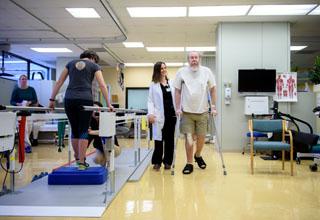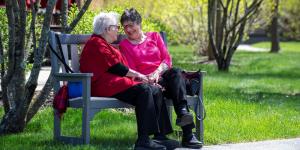When Is It Time for a Cane or Walker?
Learn about mobility aids for seniors and why you might consider using one.

A 2024 AARP survey revealed that three out of four adults aged 50 and older wish to remain in their homes and communities as they age. At the same time, many people worry about not being able to move around as well when they get older and fear they won’t be able to continue their favorite activities, visit places they love, or keep up with everyday tasks.
The good news is that assistive devices for mobility, including canes, walkers, wheelchairs, and many others that you might not be aware of, can help prevent falls and keep you safe in and out of your home. As an occupational therapist specializing in the care of older adults, I’ve observed fall risks and signs that can indicate it’s time for a mobility aid.
Mobility and fall risk in older adults
Mobility is key to maintaining independence, and one of the greatest threats to mobility in older adults is the risk of falling.
Each year, millions of older people fall. More than one in four older people falls each year, but less than half report it to their doctor. Falling once doubles your chances of falling again, and one in five falls results in a serious injury, such as a broken bone or head injury. Even without a serious injury, falls can have functional and emotional consequences.
Feeling unsteady or experiencing a fall can lead to fear of falling and anxiety surrounding everyday activities. A fear of falling may cause some people to limit their activities, leading to decreased mobility and increased dependence on others. This is where mobility aids can provide added support for seniors, helping people maintain their independence for longer.
Signs you should consider a cane or walker
It may be time to consider an assistive device for mobility, such as a cane or walker, if you:
- Feel unsteady when walking
- Rely on furniture, counters, or walls for support
- Avoid activities outside of the home due to mobility limitations or fear of falling
- Have experienced falls or near falls
Some medical situations may make an assistive device helpful, including loss of strength or frailty, an injury or joint replacement, ongoing pain (such as low back pain), or balance issues like vertigo.
The best way to think about using an assistive device is to think about it like medication. You would never take your neighbor’s pain or high blood pressure medication! It’s the same with an assistive device. You shouldn’t just accept a cane or a walker from a friend. Instead, talk to your physician and get a referral to a physical therapist who will:
- Assess your walking, balance, and strength
- Recommend the right device for you
- Adjust the device to your height and weight
- Train you in the appropriate use of the device
Types of assistive devices for mobility
There are several options available to help you navigate both indoor and outdoor environments.
These include:
- Canes
- Canes with feet/base
- Rollators
- Folding walkers
- Walkers with two wheels
- Transport wheelchairs for longer distances (e.g., medical appointments)
“Rollator” is a term you might not know, but you’ve definitely seen one. A rollator is a metal frame with handlebars and four wheels that stay in contact with the ground at all times as you walk. It may have a seat and a basket.
Each of these devices comes in a variety of shapes and styles, some with special features and optional accessories. The device that is best for you depends on your specific needs. This is a good time to remind you once again to consult with an occupational or physical therapist before choosing a mobility aid or assistive device.
You can learn more about the features and benefits of these options in a webinar I recorded:
Devices that help keep you safe after an illness, injury, or hospitalization
After an illness or hospital stay, you may find that basic tasks become a bit more challenging. As an occupational therapist, I use a range of techniques, education, and equipment to teach people how to make adjustments that allow them to perform activities of daily living.
Getting in and out of bed
There are several devices available. Some attach directly to the bed frame, while others are placed underneath the mattress. These help you pull yourself up and stand without having to adjust the bed’s height.
Bathroom safety
The bathroom is a common location for falls due to wet surfaces. The best solution is a walk-in shower, which offers both safety and energy conservation benefits. However, if you don’t have one, a wide variety of inexpensive tub chairs and benches is available, which you can use to outfit your existing tub or shower.
- Grab bars are important in the bathroom. We recommend them to everyone. Keep in mind that there’s a difference between a grab bar and a towel bar. Grab bars are anchored into studs, and towel bars usually aren’t, so they’re not interchangeable.
- Removable grab bars are a good option if you’re visiting family or friends.
- Elevating the height of your toilet seat will make getting on and off the toilet much easier. Consider a bedside commode if walking to the bathroom at night is risky for you.
We’re here to help
If you or a loved one could benefit from using an assistive device, we can help you make the right choice. Hebrew SeniorLife has both in-home and outpatient therapists who can assess your situation, make recommendations, and train you in the proper use of assistive devices that will make your life easier and keep you safe.
Our outpatient clinics are conveniently located at Hebrew Rehabilitation Center in Boston and Dedham — contact us online to get started with our outpatient rehabilitation therapy team today.
Rachel Kardon, DPT, also contributed to this post.
Blog Topics
Learn More
Outpatient Rehabilitative Therapies
At Hebrew Rehabilitation Center in Boston and Dedham, MA, we offer adult physical therapy, occupational therapy, and speech therapy using state-of-the-art mobility and treatment equipment.





